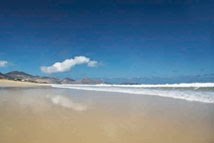 In 1496 King Manuel I petitioned the Holy See for permission to build a large monastery at the entrance to Lisbon on the banks of the Tagus River. Construction began in 1501 and the work was finished about a century later. The reason for building the Jerónimos Monastery lie, without doubt, in the wish of the monarch to reunite the Avis-Beja dynasty, of which he was the first, in a National Pantheon.
In 1496 King Manuel I petitioned the Holy See for permission to build a large monastery at the entrance to Lisbon on the banks of the Tagus River. Construction began in 1501 and the work was finished about a century later. The reason for building the Jerónimos Monastery lie, without doubt, in the wish of the monarch to reunite the Avis-Beja dynasty, of which he was the first, in a National Pantheon. King Manuel I and his descendents were buried in marble tombs placed in the Chancel of the Church and in the transept chapels. Dedication of the Monastery to the Virgin of Belém was another important factor for the King. The Jerónimos Monastery, as is generally known, was to replace the original church on the same site, dedicated to Santa Maria of Belém (St. Mary of Belém) and where the monks of the Order of Christ gave comfort to passing seamen.
The main façade of the building extends more than three hundred m etres, and the wide horizontal expanse confers a sense of repose and calm. It was constructed in stone, quarried locally in Ajuda, in the Alcântara Valley, Laveiras, River Seco and Tercena.
etres, and the wide horizontal expanse confers a sense of repose and calm. It was constructed in stone, quarried locally in Ajuda, in the Alcântara Valley, Laveiras, River Seco and Tercena.
Given the immense scale of the project and the cost of the work, building contractors and the master craftsmen responsible for them followed one after the other. Diogo de Boitaca (ca.1460-1528), João de Castilho (ca.1475-1552), Diogo de Torralva (ca. 1500-1566), Jerónimo de Ruão (1530-1601) are some of the names of those who left their indelible mark on the building, according to Monastery documents. King Manuel I poured large sums of money into the building of the Monastery at Belém. A good part of what was called the "the pepper tax" (approximately 5% of the receipts from the spice trade with Africa and the East, the equivalent of 70kg of gold per year) served to pay for the work, which, from the beginning, was strictly dependent on the King. In the 19th century architectural changes were made to the Monastery. These did not change its basic structure, but gave it the form we know tod ay. A cupola bell chamber, the dormitory (today the Archaeological Museum) and the Chapter House were some of the places, which were, altered the most.
ay. A cupola bell chamber, the dormitory (today the Archaeological Museum) and the Chapter House were some of the places, which were, altered the most.
Towards the end of the 19th century the remains Vasco da Gama and Luís de Camões were placed in the Church in tombs built by the sculpture Costa Mota.
The Jerónimos Monastery is generally referred to as the "jewel" of Manueline architecture. The unique and beautiful Manueline style draws together architectural elements of the late Gothic and Renaissance periods, and associates them with the symbols of the king, Christianity and the natural world.
King Manuel chose the monks of Order of St. Jerome (Hieronymus monks) to occupy the Monastery. Their functions were to pray for the King's soul and give spiritual comfort to seamen and navigators leaving the Restelo beach for the discovery of other lands.
Visitor Information:

Address:
Mosteiro dos Jerónimos Praça do Império,
1400-206
Lisboa
Tel: 00 351 21 362 00 34
Fax: 00 351 21 363 91 45
www.mosteirojeronimos.pt
Openning Times:
October to April from 10.00 am to 5.00 pm
May to September from 10.00 am to 6.00 pm
Last ticket sold 30 minutes before closing
Standard: € 6
Dual Ticket (Mosteiro dos Jerónimos/Torre de Belém): € 8
Tour Ticket: Lisboa Monumental (Mosteiro dos Jerónimos/Torre de Belém/ Palácio da Ajuda): € 10 Group Ticket (according to the number of visit
 ors): 100 up to 200 visitors (5% discount); 201 up to 500 visitors (10% discount); more than 500 visitors (20% discount) 65 and older and disabled by showing a suitable card: € 3 Youth Card: € 2,4 Family Card (parents with two or more children under 18, 50% discount upon the ticket price of one of the parents - mother or father): € 3 Free Admission: Children till 14 years old Sundays and Holidays till 2.00 pm For individual teachers and students (maximum 15 vistors) or teachers and students on study visit, subject to previous booking and a suitable document from school or college Lisboa Car.
ors): 100 up to 200 visitors (5% discount); 201 up to 500 visitors (10% discount); more than 500 visitors (20% discount) 65 and older and disabled by showing a suitable card: € 3 Youth Card: € 2,4 Family Card (parents with two or more children under 18, 50% discount upon the ticket price of one of the parents - mother or father): € 3 Free Admission: Children till 14 years old Sundays and Holidays till 2.00 pm For individual teachers and students (maximum 15 vistors) or teachers and students on study visit, subject to previous booking and a suitable document from school or college Lisboa Car. 


